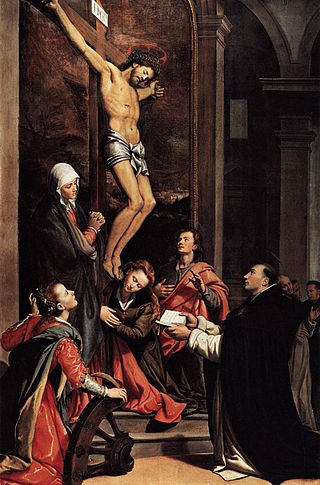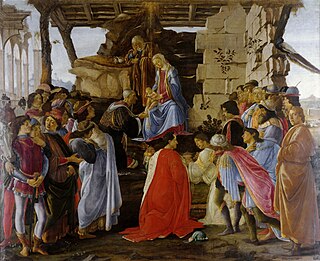
Leonardo di ser Piero da Vinci was an Italian polymath of the High Renaissance who was active as a painter, draughtsman, engineer, scientist, theorist, sculptor, and architect. While his fame initially rested on his achievements as a painter, he also became known for his notebooks, in which he made drawings and notes on a variety of subjects, including anatomy, astronomy, botany, cartography, painting, and paleontology. Leonardo is widely regarded to have been a genius who epitomized the Renaissance humanist ideal, and his collective works comprise a contribution to later generations of artists matched only by that of his younger contemporary by 23 years Michelangelo Buonarroti.

The Uffizi Gallery is a prominent art museum located adjacent to the Piazza della Signoria in the Historic Centre of Florence in the region of Tuscany, Italy. One of the most important Italian museums and the most visited, it is also one of the largest and best-known in the world and holds a collection of priceless works, particularly from the period of the Italian Renaissance.

Andrea del Castagno or Andrea di Bartolo di Bargilla was an Italian Renaissance painter in Florence, influenced chiefly by Masaccio and Giotto di Bondone. His works include frescoes in Sant'Apollonia in Florence and the painted equestrian monument of Niccolò da Tolentino (1456) in Florence Cathedral. He in turn influenced the Ferrarese school of Cosmè Tura, Francesco del Cossa and Ercole de' Roberti.

The Palazzo Vecchio is the town hall of Florence, Italy. It overlooks the Piazza della Signoria, which holds a copy of Michelangelo's David statue, and the gallery of statues in the adjacent Loggia dei Lanzi.

Santi di Tito was one of the most influential and leading Italian painters of the proto-Baroque style – what is sometimes referred to as "Counter-Maniera" or Counter-Mannerism.

The Bargello, also known as the Palazzo del Bargello or Palazzo del Popolo, is a former barracks and prison in Florence, Italy. Since 1865, it has housed the Museo Nazionale del Bargello, a national art museum.

The Adoration of the Magi is an unfinished early painting by the Italian Renaissance artist Leonardo da Vinci. Leonardo was given the commission by the Augustinian monks of San Donato in Scopeto in Florence in 1481, but he departed for Milan the following year, leaving the painting unfinished. It has been in the Uffizi Gallery in Florence since 1670.

Anghiari is a hill town and municipality (comune) in the Province of Arezzo, Tuscany, Italy.

The Battle of Anghiari was fought on 29 June 1440, between the forces of Milan and the League of some Italian states led by the Republic of Florence in the course of the Wars in Lombardy. The battle was a victory for the Florentines, who secured their domination of central Italy.

The Battle of Anghiari (1505) was a planned painting by Leonardo da Vinci in the Salone dei Cinquecento in the Palazzo Vecchio, Florence. Its central scene would have depicted four men riding raging war horses engaged in a struggle for possession of a standard at the Battle of Anghiari in 1440.
Events from the year 1504 in art.
The Leonardo da Vinci International Award is an annual international prize named after Leonardo da Vinci, to award outstanding achievement by young people involved in the study of the sciences, technology, literature and the arts. Among the disciplines recognised and rewarded so far have been painting, sculpture, music, geology, architecture, medicine and nuclear physics. Its previous laureates include musicians Evelyn Glennie and Leonidas Kavakos.
The decade of the 1450s in art involved many significant events, especially in sculpture.

The Adoration of the Magi is a painting by the Italian Renaissance master Sandro Botticelli. Botticelli painted this piece for the altar in Gaspare di Zanobi del Lama's chapel in Santa Maria Novella around 1475. This painting depicts the Biblical story of the Three Magi following a star to find the newborn Jesus. The image of the altarpiece centers on the Virgin Mary and the newborn Jesus, with Saint Joseph behind them. Before them are the three kings who are described in the New Testament story of the Adoration of the Magi. The three kings worship the Christ Child and present him with gifts of gold, frankincense and myrrh. In addition, the Holy Family is surrounded by a group of people who came to see the child who was said to be the son of God.

The Battle of Cascina is a never-completed painting in fresco commissioned from Michelangelo for the Palazzo Vecchio in Florence. He created only the preparatory drawing before being called to Rome by Pope Julius II, where he worked on the Pope's tomb; before completing this project, he returned to Florence for some months to complete the cartoon.

The Battle of Cascina was an engagement between Pisan and Florentine troops on 28 July 1364 near Cascina, modern-day Italy. Florence's victory followed a recent defeat to Pisan forces that had enabled mercenary John Hawkwood, who was in command of the Pisan army, to occupy the Valdinievole, Prato en route to Florence. Hawkwood and his army looted the lucrative Mugello region and Pistoia before proceeding towards Florence. Hawkwood fought alongside Hanneken von Baumgarten and had 3,000 men-at-arms at his disposal.

Hernando de los Llanos was a Spanish painter active primarily around Cuenca for the duration of his career. Little is known about his life or training, though he appears to have been familiar with the models of Leonardo da Vinci and Domenico Ghirlandaio. He worked for a time in Valencia in collaboration with Fernando Yáñez de la Almedina. Hernando los Llanos can be considered to be one of Leonardeschi, at the beginning of 16th century he and Yáñez traveled to Florence and collaborated with Leonardo for his The Battle of Anghiari fresco. Collaboration was fruitful enough, while de los Llanos continued his artistic association on returning home to Spain. He and Yáñez produced several copies after works of Leonardo da Vinci, including:
John Fredrich Asmus is a research physicist who has focused his work on the use of scientific techniques in art conservation. As of 2020, he taught at the Institute for Pure and Applied Physical Science at the University of California, San Diego, where he began working in 1974.

The Sala delle Asse, is a large room in the Castello Sforzesco in Milan, the location of a painting in tempera on plaster by Leonardo da Vinci, dating from about 1498. Its walls and vaulted ceiling are decorated with "intertwining plants with fruits and monochromes of roots and rocks" and a canopy created by sixteen trees.

The Metropolitan City of Florence is an administrative division called metropolitan city in the Tuscany region, Italy. Its capital is the city of Florence. It replaced the Province of Florence. It was first created by the reform of local authorities and then established by the Law 56/2014. It has been operative since 1 January 2015.














